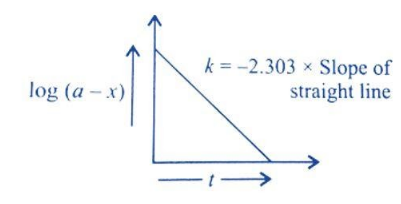
A plot of log(a-x) against time ’t’ is a straight line. This indicates that the reaction is of:
(A) Zero order
(B) First order
(C) Second order
(D) Third order
Answer
512k+ views
Hint: Reaction in which the reaction rate is linearly dependent on the concentration of only one reactant is called a first order reaction.
Complete step by step answer:
We know that for a first order reaction,
\[{\text{ - }}\dfrac{{{\text{dC}}}}{{{\text{dt}}}}{\text{ = k}}{\text{.C}}\]
On integrating we get, \[\int\limits_{{{\text{C}}_{\text{0}}}}^{\text{C}} {\dfrac{{{\text{dC}}}}{{\text{C}}}} {\text{ = - k }}\int\limits_{\text{0}}^{\text{t}} {{\text{dt}}} \]
Where, \[{{\text{C}}_0}\] is the concentration of the reactant at time t = 0 and C is the concentration of the reactant at time t = t.
So, we get, \[{\text{log C - log}}{{\text{C}}_0}{\text{ = - k}}{\text{. t}}\]
\[{\text{log C = - k}}{\text{.t + log }}{{\text{C}}_0}\]
But, \[{\text{log }}{{\text{C}}_0}\] is the initial concentration of the reactant which will be constant. So, if \[{{\text{C}}_0}\] i.e. initial concentration of the reactant is considered to be ‘a’ then C which is concentration at time t will be (a-x).
So, we write it as \[{\text{log (a - x) = - k}}{\text{.t + log a}}\]. This equation is of the form \[{\text{y = mx + c}}\].
Thus, graph of log(a-x) against time ’t’ will look like –

Hence, option B is correct.
Additional information:
The power dependence of rate on the concentration of all reactants is called as order of the reaction. When the rate of reaction depends on concentration of only one reactant, it is called as a first order reaction.
The rate of reaction is independent of the concentration of the reactants, the reaction is said to be zero order reaction.
When the rate of a reaction depends either on the concentration of one reactant squared or from the concentration of two separate reactants, the reaction is called a second order reaction.
Note: A plot of log(a-x) against time ’t’ is a straight line is a very peculiar feature of first order reactions only. Hence, the answer is first order reaction.
Complete step by step answer:
We know that for a first order reaction,
\[{\text{ - }}\dfrac{{{\text{dC}}}}{{{\text{dt}}}}{\text{ = k}}{\text{.C}}\]
On integrating we get, \[\int\limits_{{{\text{C}}_{\text{0}}}}^{\text{C}} {\dfrac{{{\text{dC}}}}{{\text{C}}}} {\text{ = - k }}\int\limits_{\text{0}}^{\text{t}} {{\text{dt}}} \]
Where, \[{{\text{C}}_0}\] is the concentration of the reactant at time t = 0 and C is the concentration of the reactant at time t = t.
So, we get, \[{\text{log C - log}}{{\text{C}}_0}{\text{ = - k}}{\text{. t}}\]
\[{\text{log C = - k}}{\text{.t + log }}{{\text{C}}_0}\]
But, \[{\text{log }}{{\text{C}}_0}\] is the initial concentration of the reactant which will be constant. So, if \[{{\text{C}}_0}\] i.e. initial concentration of the reactant is considered to be ‘a’ then C which is concentration at time t will be (a-x).
So, we write it as \[{\text{log (a - x) = - k}}{\text{.t + log a}}\]. This equation is of the form \[{\text{y = mx + c}}\].
Thus, graph of log(a-x) against time ’t’ will look like –

Hence, option B is correct.
Additional information:
The power dependence of rate on the concentration of all reactants is called as order of the reaction. When the rate of reaction depends on concentration of only one reactant, it is called as a first order reaction.
The rate of reaction is independent of the concentration of the reactants, the reaction is said to be zero order reaction.
When the rate of a reaction depends either on the concentration of one reactant squared or from the concentration of two separate reactants, the reaction is called a second order reaction.
Note: A plot of log(a-x) against time ’t’ is a straight line is a very peculiar feature of first order reactions only. Hence, the answer is first order reaction.
Recently Updated Pages
Electricity and Magnetism Explained: Key Concepts & Applications

JEE Energetics Important Concepts and Tips for Exam Preparation

JEE Isolation, Preparation and Properties of Non-metals Important Concepts and Tips for Exam Preparation

JEE Main 2021 July 25 Shift 1 Question Paper with Answer Key

JEE Main 2021 July 22 Shift 2 Question Paper with Answer Key

States of Matter Chapter For JEE Main Chemistry

Trending doubts
JEE Main 2026: Application Form Open, Exam Dates, Syllabus, Eligibility & Question Papers

Derivation of Equation of Trajectory Explained for Students

Hybridisation in Chemistry – Concept, Types & Applications

Understanding the Angle of Deviation in a Prism

Understanding Atomic Structure for Beginners

How to Convert a Galvanometer into an Ammeter or Voltmeter

Other Pages
Solutions Class 12 Chemistry Chapter 1 CBSE Notes - 2025-26

NCERT Solutions For Class 12 Chemistry Chapter 1 Solutions - 2025-26

The D and F Block Elements Class 12 Chemistry Chapter 4 CBSE Notes - 2025-26

NCERT Solutions for Class 12 Chemistry Chapter Chapter 7 Alcohol Phenol and Ether

NCERT Solutions ForClass 12 Chemistry Chapter Chapter 8 Aldehydes Ketones And Carboxylic Acids

JEE Advanced Marks vs Ranks 2025: Understanding Category-wise Qualifying Marks and Previous Year Cut-offs




